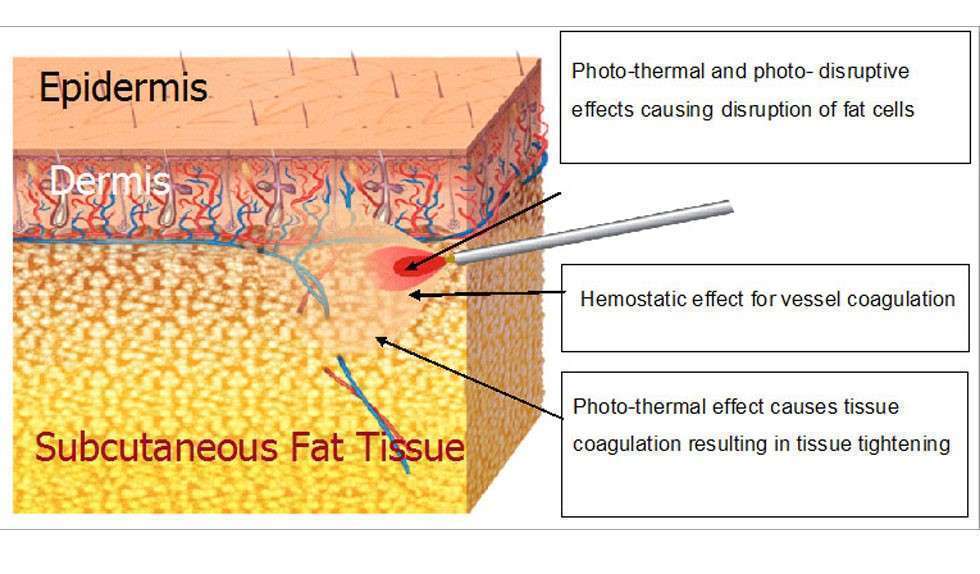Lipolysis Laser for Fat Removal and Skin Tightening
Laser-assisted lipolysis is a minimally invasive procedure for the removal of stubborn pockets of fat. It can effectively reduce areas of fat resistant to diet or exercise with minimal side effects than traditional liposuction. The procedure uses a laser to effectively “melt” unwanted fat and then either allows the body to metabolize the melted fat or uses “aspiration”, a form of suction that allows the practitioner to remove greater quantities of fat.
Although it has been touted as a lunchtime treatment, laser-assisted lipolysis is classified as a minor surgical procedure. Laser-assisted lipolysis is not a weight loss alternative but is effective for those with small localized areas of stubborn fat.

How Does Dimed Medical Laser Work for Lipolysis?
The procedures were performed in the hospital, and the type of anesthesia was general, regional (epidural), or local with sedation, according to the extent and indications of each case. using a 0.9% saline solution with a temperature of around 4°C, and 1:500,000 epinephrine. The infiltration was performed preferably with the aid of a continuous pressure system at 150mm Hg, provided by placing the reservoir solution with a cuff pressure drop, to allow a homogeneous distribution during infusion with a 2mm diameter needle. A uniform deposit was performed only in the deepest layer, parallel to the muscular plane, to avoid tunneling the fat tissue. The infused volume was equivalent to the estimated volume drawn from each region. This infiltration technique took 7 to 8 min to infuse 1 liter into each decubitus, an adequate period for vasoconstriction.
A 980nm wavelength diode laser equipment was used in all treatments. A 2mm diameter rigid cannula with a 600µm optical fiber was used to transfer energy to the tissues. The passage of the laser was initiated in the deep layers, with slow fan-shaped movements, at a rate of about 2.5 cm/s, from the incision, with the application of back-and-forth laser movements, always with the free control of the operator’s hand on the treated region to maintain the distance from the end of the fiber to the surface. At the end of the outward stroke of each passage, the fiber end was maintained at a safe distance from the skin, with the aid of a red light display, to avoid injury. After the passage of the annula into the deeper plane, passes were made with the same care in the middle plane, and then the more superficial plane to the skin surface.
For body treatment, power was maintained between 18 and 22W, except in the submental region, inner arms, and thighs, where 14 to 16W was used.
Now Dimed 15 watts 1210nm wavelength has absorption-affinity for Lipid-Rich Tissue and has been demonstrated to stimulate adipocytes and mesenchymal cells of the subcutaneous tissue, with a new concept: Selective Photothermostimulation (SPS). The application is liposuction of this wavelength is determined by its preservation of the integrity of adipocytes, making possible the use of these materials for fat grafting in Liposculpture, Breast Reconstruction, or as filler in Face Rejuvenation, proven that this technique is less traumatic.


Laser Lipolysis Treatment Areas Include:
Face
- Blepharoplasty
- Lower eyelid
- Mandibular border
- Under chin
- Neck
- Mid and lower fae
Body
- Ankle
- Knee
- Inner thigh
- Inner arm
- Gynaecomastia
- Abdomen and peri-umbilical area
Clinical Advantages of Laser Lipolysis Treatment
- May be conducted in doctors’ rooms
- Minimal invasiveness
- Virtually no blood loss
- Fat may be removed evenly
- Minimal recovery time
- Usually no loose skin due to heat shrinkage
- Previously difficult areas can now be treated
- Several areas can be treated at the same time with virtually invisible entry points
- Can be performed as a “walk in and walk out” procedure
- Suitable for most areas

